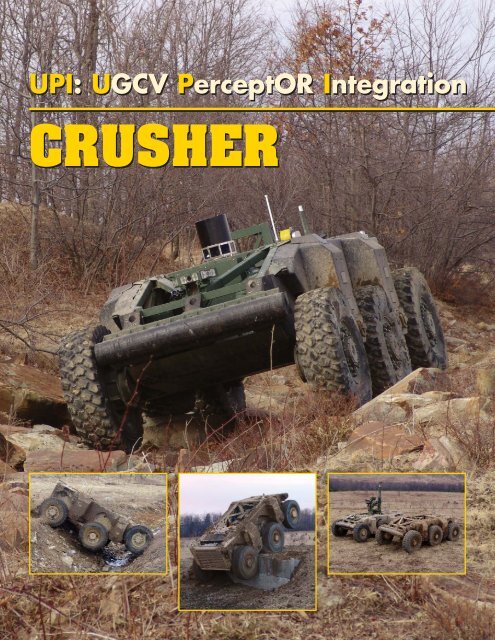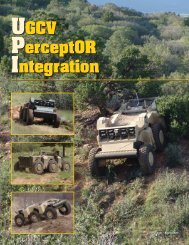CRUSHER - National Robotics Engineering Consortium - Carnegie ...
CRUSHER - National Robotics Engineering Consortium - Carnegie ...
CRUSHER - National Robotics Engineering Consortium - Carnegie ...
You also want an ePaper? Increase the reach of your titles
YUMPU automatically turns print PDFs into web optimized ePapers that Google loves.
UPI: UGCV PerceptOR Integration<br />
<strong>CRUSHER</strong>
<strong>CRUSHER</strong><br />
UNMANNED GROUND<br />
COMBAT VEHICLE<br />
THE VEHICLE<br />
The Crusher vehicle was created as<br />
part of the UPI program at the <strong>National</strong><br />
<strong>Robotics</strong> <strong>Engineering</strong> Center (NREC) of<br />
<strong>Carnegie</strong> Mellon University. The UPI<br />
program features quarterly field experiments<br />
that assess the capabilities of<br />
large scale, unmanned ground vehicles<br />
(UGV) operating autonomously in a<br />
wide range of complex, off-road terrains.<br />
UPI's aggressive mobility, autonomy<br />
and mission performance objectives<br />
required two additional test platforms<br />
that could accommodate a variety of<br />
mission payloads and state of the art<br />
autonomy technology. Crusher represents<br />
the next generation of<br />
the original Spinner<br />
platform,<br />
Crusher’s suspension system allows it to maintain high offroad speeds across extreme terrains.<br />
the world's first greater-than-6-ton,<br />
cross-country UGV designed from the<br />
ground up. Crusher offers more mobility,<br />
reliability, maintainability and flexibility<br />
than Spinner, at 29 percent less weight.<br />
TOMORROW'S TECHNOLOGY<br />
AVAILABLE TODAY<br />
Crusher has a new space frame hull<br />
designed by CTC Technologies and<br />
made from high-strength aluminum tubes<br />
and titanium nodes. A suspended and<br />
shock-mounted skid plate made from<br />
high-strength steel allows Crusher to<br />
shrug off massive, below-hull strikes<br />
from boulders and tree stumps. The nose<br />
was completely redesigned for Crusher<br />
to sustain normal impacts with<br />
trees and brush while also<br />
absorbing the impact of major<br />
collisions.<br />
Suspensions designed by Timoney support<br />
30 in. of travel with selectable stiffness<br />
and reconfigurable ride height.<br />
Crusher can comfortably carry over<br />
8000 lbs. of payload and armor.<br />
Crusher's hybrid electric system allows<br />
the vehicle to move silently on one battery<br />
charge over miles of extreme terrain.<br />
A 60kW turbo diesel engine maintains<br />
charge on the high-performance<br />
SAFT-built lithium ion battery module.<br />
Engine and batteries work intelligently<br />
to deliver power to Crusher's 6-wheel<br />
motor-in-hub drive system built around<br />
UQM traction motors.<br />
By mid 2006, NREC will integrate its<br />
latest automation technology onto both<br />
Crusher vehicles. A combination of ladar<br />
and camera systems allow the vehicles<br />
to dynamically react to obstacles and<br />
travel through mission waypoints<br />
spaced over a kilometer apart. The use<br />
of overhead data via terrain data<br />
analysis will continue to be<br />
utilized for global planning.<br />
Over the next year<br />
these two vehicles will<br />
analyze, plan, and<br />
execute mobility missions<br />
over extreme terrains<br />
without any human<br />
interaction at all.
18-foot telescoping mast enables covert surveillance in dense environments.<br />
A WINDOW TO THE FUTURE<br />
As a core building block in the Army's<br />
future force, tactical UGVs enable new<br />
war-fighting capabilities while putting<br />
fewer soldiers in harm's way. The full<br />
benefit of this new capability can only<br />
be achieved with field-validated understanding<br />
of UGV technology limits and<br />
consideration of the impact to Army<br />
doctrine, personnel, platforms and infrastructure.<br />
UPI experiments encompass<br />
vehicle safety, the effects of limited communications<br />
bandwidth and GPS infrastructure<br />
on vehicle performance, and<br />
how vehicles and their payloads can be<br />
effectively operated and supervised. The<br />
UPI program invites military personnel,<br />
requirement developers, acquisition<br />
professionals, Future Combat Systems<br />
performers and researchers to observe<br />
and participate in UPI experiments.<br />
Unloaded vehicle weight 13,200 lbs<br />
Maximum payload/armor 8,000 lbs (maintaining capability)<br />
Length 201 in<br />
Width 102 in<br />
Height (w/16 in ground clearance) 60 in<br />
Ground clearance 0-30 in (reconfigurable)<br />
Tire diameter 49.5 in<br />
Top speed 26 mph (40 deg (traction limited)<br />
Side slope >30 deg (traction limited)<br />
Step climb >4 ft<br />
Gap/trench crossing >80 in<br />
Engine Turbo diesel<br />
Generator output 58 kW/78 hp<br />
Onboard battery storage 18.7 kW-hr energy<br />
Traction motors 210 kW/282HP continuous<br />
Peak torque 40,000 ft-lb (6WD)<br />
Payload volume (internal)<br />
Payload power<br />
Control modes<br />
41.6 ft3 main bay (inside hull)<br />
16.1 ft 3 front bay (inside hull)<br />
28V, 5kW<br />
300V, 10kW<br />
Wireless pendant control (RC)<br />
Teleoperation control<br />
Waypoint following<br />
Full autonomy
The <strong>National</strong> <strong>Robotics</strong> <strong>Engineering</strong><br />
Center (NREC) develops and delivers<br />
leading edge automation technology to<br />
industry and government to enable new<br />
products and capability. Founded in<br />
1995 as an operating unit within<br />
<strong>Carnegie</strong> Mellon's <strong>Robotics</strong><br />
Institute, NREC employs<br />
over 125 scientists, technical<br />
staff, graduate students<br />
and support personnel. The<br />
100,000 sq. ft. facility is only<br />
a ten minute drive from the <strong>Carnegie</strong><br />
Mellon campus.<br />
We partner with clients so that our technology<br />
can be transitioned as quickly<br />
and effectively as possible. We mitigate<br />
client risk by continual team focus on<br />
GOVERNMENT<br />
SPONSORS<br />
4/06 1M<br />
Ten 40th Street, Pittsburgh, PA 15201<br />
412.681.6900 • FAX 412.681.6961<br />
info@rec.ri.cmu.edu www.rec.ri.cmu.edu<br />
NREC<br />
measurable project objectives, accelerated<br />
product development, reuse of<br />
core NREC technologies and extensive<br />
field testing under real-world conditions.<br />
NATIONAL ROBOTICS<br />
ENGINEERING CENTER<br />
(Above) Gladiator, an unmanned robotic vehicle that exhibits<br />
high mobility and advanced robotic scouting capabilities<br />
required for the Ground Combat Element of the United States<br />
Marine Corps.<br />
(Left) Dragon Runner, developed for the US Marine Corps<br />
Warfighting Laboratory, is a small, man-portable robot,<br />
capable of inverted operation and designed to increase<br />
situational awareness.



